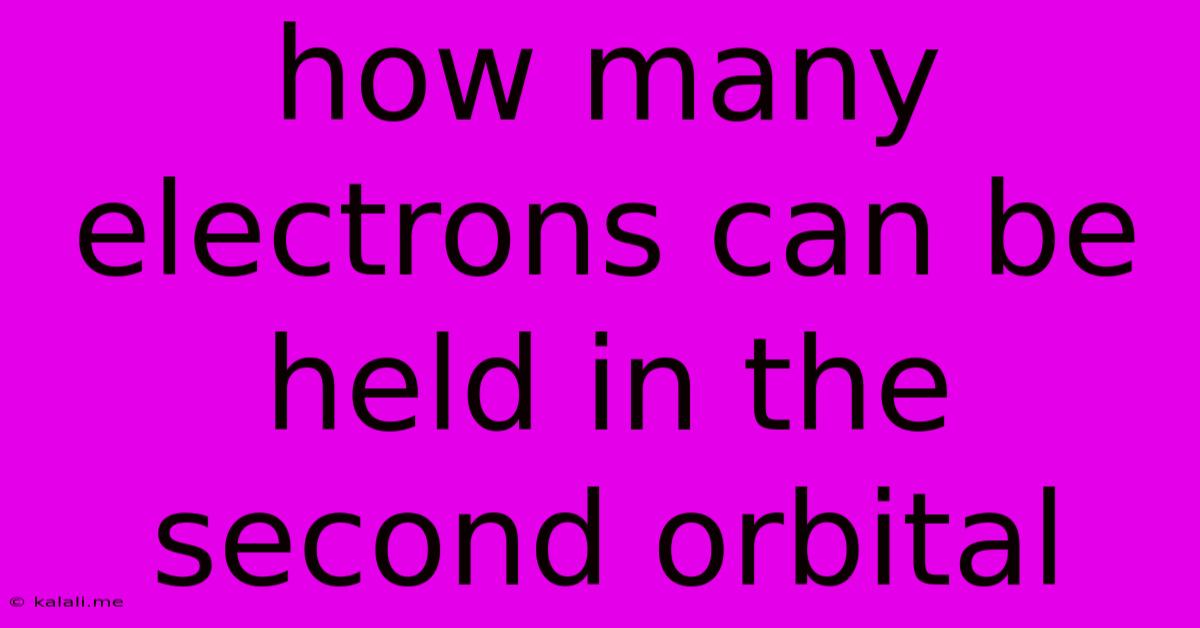How Many Electrons Can Be Held In The Second Orbital
Kalali
May 10, 2025 · 3 min read

Table of Contents
How Many Electrons Can the Second Orbital Hold? A Deep Dive into Electron Configuration
Understanding electron configuration is fundamental to grasping the behavior of atoms and molecules. A frequent question revolves around the capacity of different electron shells or orbitals. This article will delve into the specifics of the second electron shell, explaining precisely how many electrons it can accommodate and why. Learn how this relates to the periodic table and chemical properties of elements.
The second electron shell, also known as the second energy level or principal quantum number n=2, is further divided into sub-shells. This is crucial to understanding its electron capacity. Unlike the first shell (n=1), which only has one sub-shell, the second shell has two: the s sub-shell and the p sub-shell.
The s Sub-shell: A Single Orbital
The s sub-shell contains only one orbital. Each orbital can hold a maximum of two electrons, according to the Pauli Exclusion Principle. Therefore, the s sub-shell in the second energy level (2s) can hold a total of two electrons.
The p Sub-shell: Three Orbitals
The p sub-shell is more complex. It consists of three orbitals, each capable of holding two electrons. These orbitals are often represented as px, py, and pz, indicating their orientation in three-dimensional space along the x, y, and z axes. Since each orbital can hold two electrons, the p sub-shell (2p) can accommodate a total of six electrons (3 orbitals x 2 electrons/orbital).
Total Electron Capacity of the Second Shell
To determine the total number of electrons the second shell can hold, we simply add the capacities of its subshells:
- 2s sub-shell: 2 electrons
- 2p sub-shell: 6 electrons
- Total: 2 + 6 = 8 electrons
Therefore, the second electron shell can hold a maximum of eight electrons. This principle applies to all atoms. Once the second shell is full, subsequent electrons fill the next energy level.
Implications for Chemical Properties and the Periodic Table
The electron configuration of an atom, particularly the filling of its outermost shell (valence electrons), dictates its chemical properties. Elements with a full outer shell (like noble gases) are exceptionally stable and unreactive. Understanding the capacity of each shell allows us to predict how atoms will interact and form chemical bonds. This is directly reflected in the organization of the periodic table.
The second shell's capacity of eight electrons directly correlates with the behavior of elements in the second and third periods of the periodic table. The filling of the 2s and 2p orbitals drives the periodic trends observed across these elements.
Conclusion: Eight Electrons and Beyond
In summary, the second electron shell can hold a maximum of eight electrons, distributed across its s and p subshells. This fundamental concept is crucial for comprehending atomic structure, chemical bonding, and the organization of the periodic table. Understanding the electron capacity of different energy levels is key to unlocking a deeper understanding of chemistry.
Latest Posts
Latest Posts
-
What Is 20 Percent Of 800 000
Jul 12, 2025
-
Words That Start With Y In Science
Jul 12, 2025
-
Prevent An Expressway Emergency By Merging Without
Jul 12, 2025
-
How Many Grams Of Sugar In A Pound
Jul 12, 2025
-
7am To 11am Is How Many Hours
Jul 12, 2025
Related Post
Thank you for visiting our website which covers about How Many Electrons Can Be Held In The Second Orbital . We hope the information provided has been useful to you. Feel free to contact us if you have any questions or need further assistance. See you next time and don't miss to bookmark.